Backyard Rabbit Keeping, Part 6/15 – Feeding
Rabbits need roughly the same constituents in their food as other animals and as we do, with one or two exceptions. They are herbivorous and will eat most greenfood, grains and roots. If you want an easy life, the commercial rabbit pellets are balanced and need no additives and no special knowledge. An adult rabbit will eat about four ounces a day of this concentrated food, going up to about eight ounces for a doe with young. But if as I imagine you would like to find the food for your rabbits yourself, and supplement greens with a mash made from household scraps, you will have to think a bit more about balancing a diet. Briefly, the needs are these:
Carbohydrates: These provide energy. Surplus carbohydrates are stored as fat and if your does get too much of them, they may become too fat to breed. Rabbits will in fact balance their own ration when they can. They will eat more food if it is low in energy and less if it is high – if they are given the choice. The danger here is that a very high energy diet could reduce their intake and they could end up short of other food constituents.
Proteins: In general it is supposed that the ration should contain about 18% protein. These build up the body tissues of the animal. The young growing rabbit is thus the most in need of protein, and the pregnant doe needs extra to produce her litter. This is usually the expensive part of the ration, and the most difficult to provide in a vegetarian diet. During the war, soaked dried peas were fed to rabbits for protein. Unless you grow your own, these are now too expensive. There is a good deal of protein in greenfood and a constant supply of varied greens should produce some of the necessary protein. Good hay is another source; which is why your hay should always be the best you can get.
Fiber: Wild rabbits eat a lot of fiber. Hay provides this but too much can impair digestion. Young rabbits and breeding stock should have a less fibrous diet than older rabbits. Pelleters reckon to include about 14% fiber, but this is a minimum. Adult rabbits can deal with a ration composed of up to 25% fiber.
Minerals: These are provided by greenfood in a natural ration, but they have to be added to pellets. Rabbits appear to need all the usual minerals except cobalt.
Vitamins: Rabbits can make some of their own vitamins for themselves. The habit of pseudo-rumination ensures that vitamins of the B complex which are produced in the last part of the intestines by the bacteria living there, can be used by the rabbit. Vitamin B is contained in the soft pellets; this has been proved by experiment. It seems that they may also make Vitamin C, but backyard rabbits will get plenty of this in their normal diet, so the question is not a vital one. The other vitamins are important in the diet; A, D (a deficiency of this causes rickets in young rabbits) and E. It has been suggested that coccidiosis may be more likely to attack when rabbits are short of Vitamin E.
So, leaving aside the commercial pellets, how shall we feed our rabbits economically at the right levels of all these requirements?
 If we go back to the wild rabbit, and watch it feed on a bank in the evening sun, the most noticeable thing is the way it hops about, nibbling at this and that. Rabbits like variety and when they are in your backyard it is up to you to provide it. No doubt this preference is nature’s way of making sure that all the vitamins, minerals and so on are provided, since different plants wilt supply different needs. It is also a safeguard against a sudden change of diet.
If we go back to the wild rabbit, and watch it feed on a bank in the evening sun, the most noticeable thing is the way it hops about, nibbling at this and that. Rabbits like variety and when they are in your backyard it is up to you to provide it. No doubt this preference is nature’s way of making sure that all the vitamins, minerals and so on are provided, since different plants wilt supply different needs. It is also a safeguard against a sudden change of diet.
We have always fed a mash in the morning and greenfood at night, keeping the hay rack topped up all the time so that they can have as much as they like. Mash supplies carbohydrate and some protein. The greenfood will have everything in varying amounts. Some people only feed once a day but twice is better. It is important not to overfeed or to let the rabbits go hungry, and it is easier to regulate the diet if you feed twice a day; it need not take long.
If you give them too much, they will leave some – a sign that the ration should be cut down. Always remove stale food. Fermenting and sour food is very bad for rabbits. If a dog gets something undesirable it is sick and that’s that, but rabbits cannot be sick. Of course, if all the food has vanished and all the hay, give them a bit more unless they are really fat. Feeding rabbits depends on your observation in this way much more than in weighing out food to the last ounce, in backyard conditions anyway. It is impossible to weigh out the exact requirements unless you know the exact analysis of the food, and that is only the case with pellets – a powerful argument for using them commercially.
 When pellets are fed, rabbits from 8 weeks onwards get about 3 ounces per day. Pregnant does get 4 ounces but this is increased to 8 ounces gradually as the pregnancy goes on. How do we apply this to natural feeding? There is bound to be more bulk involved, because natural feeds are rarely so concentrated. As a rough guide, an adult rabbit will eat a portion of mash about the size of a tangerine. This can be made from stale bread, porridge (oats are good) or boiled potato peelings, anything like that, moistened and then dried off with bran. The mash should be dry and crumbly, not soggy and not dusty. Some rolled oats can be kept as a standby for days when nobody leaves anything for the rabbits. Or you can toast stale bread really hard – they love to gnaw away at it. Neighbors may be glad to give you their stale bread if you are too thrifty to have much to spare yourselves.
When pellets are fed, rabbits from 8 weeks onwards get about 3 ounces per day. Pregnant does get 4 ounces but this is increased to 8 ounces gradually as the pregnancy goes on. How do we apply this to natural feeding? There is bound to be more bulk involved, because natural feeds are rarely so concentrated. As a rough guide, an adult rabbit will eat a portion of mash about the size of a tangerine. This can be made from stale bread, porridge (oats are good) or boiled potato peelings, anything like that, moistened and then dried off with bran. The mash should be dry and crumbly, not soggy and not dusty. Some rolled oats can be kept as a standby for days when nobody leaves anything for the rabbits. Or you can toast stale bread really hard – they love to gnaw away at it. Neighbors may be glad to give you their stale bread if you are too thrifty to have much to spare yourselves.
During the war, the only bought-in food available for rabbits was bran, which is more fiber than anything else. It was mixed with scraps to feed thousands of backyard rabbits. Bran is no longer cheap since it costs as much as pellets. Even so, it is a better buy for backyard rabbits. It will not be fed straight, but used to dry off mash and so it will go a lot further.
The hay should be the very best you can get; it might be best to try and make it yourself. There can be a lot of protein in well-made lucerne (alfalfa) hay, and this is the standby of the American rabbit industry. If you make hay yourself, turn it often and store it loose if possible. It should be dry, dark green and fragrant; don’t store it until it is really dry or it will go moldy. But don’t go too far the other way – beginners sometimes leave hay out in the sun too long, until it is bleached the color of straw. This sort of hay has lost a lot of its goodness.
Lawn clips are rather more lacerated than grass cut for hay and so lose more of their goodness, but if they are dried properly this is useful winter food. Do not let them heat up, and avoid them if cats and dogs have visited the lawn.
The odd shower of rain will not spoil your hay irrevocably, but mold or dusty hay should not be fed to rabbits. Avoid it yourself if you can; inhaling spores from mold hay can lead to a condition known as “Farmer’s Lung.”
If you need to buy hay, try to get it about July, it is usually cheaper then. You may be able to leave it at the farm until it is needed if there is a shortage of storage space at home. Wherever it is, it must be under cover.
Wild Greens:
The main thing is to be able to recognize the common wild plants so that you can select the right ones for rabbits. An illustrated botany book will soon put you right. No doubt you will be as keen as we are on conservation and you will not go into an area and denude it of vegetation.
Many people are against the idea of picking any wild plants these days, but it is a matter of common sense. You will be doing it within reason and for a useful purpose.
Wild green food included young tree leaves and shoots. These would be the natural spring food of the wild rabbits, and if you can provide a few without deforestation it might be a good idea. Sometimes there can be a danger in feeding young oak leaves very early in spring, so only give shoots in moderation. Rabbits love gnawing things, so shoots will please them. Acorns were also dried for rabbit food during the war; fallen acorns were collected and spread out in a shed, and then stored.
With green plants in general though, it is better to avoid the seeds. Sometimes they can be mildly poisonous when the plant is not. Clovers and vetches are an example; avoid their seeds if you can. These are legumes, high in protein and very useful. Vetches are often found climbing over other plants in the hedgerows. Here are a few other useful wild plants:
 |
Coltsfoot: This is a troublesome weed in the garden; herbalists use it in cough mixtures. The yellow flowers appear very early in the spring. The big round leaves are more apparent later. This is the sort of plant that gives the rabbits a change when garden greens are scarce. |
 |
Comfrey: This grows wild and there is also a cultivated sort – see later. Some people say that wild rabbits avoid it, but backyard ones like it well enough. It is a big bulky plant which makes gathering easier! In olden days it was called the bone setters’ herb, and was used during the Crusades to heal wounds and to set broken bones. |
 |
Chickweed: It is useful because it always seems to be there; it seems to grow even in cracks in concrete, all the year round. It contains a lot of copper, which in ways not fully understood, seems to improve digestion. |
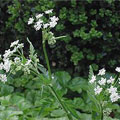 |
Cow Parsley: The Wiltshire name for this is Rabbits Meat, which speaks for itself. Another useful plant, but I was always afraid of confusing it with Fool’s Parsley, a poisonous weed. |
 |
Docks: These are not eaten much by cattle and sheep and farmers consider them an unmitigated nuisance, so if you see a patch growing on private land you should be able to gather some for the rabbits. Use only the leaves – the seeds are sometimes poisonous. We feed docks mixed in with lush grass, as they will counteract its laxative tendency. The dock is an antiseptic plant and cooling to inflamed skin – remember how it feels on nettle stings; so it is useful for treating ailments too. |
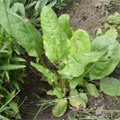 |
Sorrel (Sour Dock): This is a tasty bite in the Spring. Our ancestors used to gather it for themselves and make Sour Dock Pudding. It is juicy and acid, and must have tasted good after a long winter. |
 |
Dandelion: A well known food for rabbits, but it should not be fed in large quantities. When mixed with other foods it acts as a tonic, rather as we mix young dandelion leaves with our own salads sometimes. |
 |
Fat Hen: Useful in small doses, this is a common garden weed. It is related to the perennial herb Good King Henry, and used to be grown as a vegetable, so it tends to be more common at the sites of old villages. |
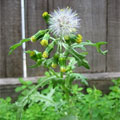 |
Groundsel: This got its name from the Old English “ground swallower” because it covers the ground so quickly. It has always been used by backyard rabbit keepers to get their rabbits through the molt. Once again, feed small quantities at a time. Groundsel is sometimes attacked by a fungus and if this happens, don’t use it. |
 |
Heather: Another astringent plant, eaten by moorland rabbits. It can add variety to the diet if you live anywhere near a heather moor. The young spring shoots are the favorites, and they could be useful when grass is scarce. |
 |
Ivy: We have fed ivy leaves in a hard winter when there was little else available, The rabbits liked them, as do wild rabbits. In summer and in the autumn when there are berries on the plants, avoid it; the flowers and berries are purgative. In fact the plant is a strong one and too many leaves are not good for stock. Herbalists give them as a tonic to animals which have just given birth. |
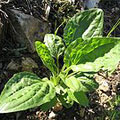 |
Plantago: This little plant seems to grow wherever there is a pathway made by man. If you find clean specimens, collect them for the rabbits. |
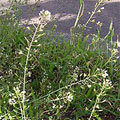 |
Shepherds Purse: This again is good medicinally – see later. Again, avoid any plants covered in fungus. |
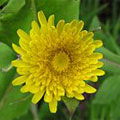 |
Sow Thistle: This is also called milk thistle because it has a white milky juice in the hollow stem. The flowers are bright yellow, rather like a dandelion, and the leaves are green and although pointed, are not very prickly. Rabbits love them, and as these plants grow to a considerable size, they can be useful if you are in a hurry. But try to get young ones; this year I left one in a corner to see how big it would grow, and by the time my experiment was finished the plant was huge, tough and suitable only for pigs and not rabbits. |
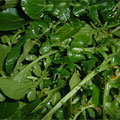 |
Watercress: This is a very good winter salad for rabbits and for us, rich in iron and other minerals. It will sometimes tempt a sick rabbit to eat. Make sure that you pick it from running water and wash it before feeding, because this plant can be contaminated by the cysts of liver fluke, which can attack rabbits and humans alike. The gray water snail is the alternate host to the fluke, which then migrates to the liver of a bigger animal – sheep, cow or rabbit. Wild rabbits on wet ground get liver fluke and it would be a pity to introduce ii to your rabbits. Symptoms are anaemia, loss of condition and weight. |
These are only a few of the useful plants you may find when out hunting for rabbit food. Perhaps we should now consider the more common plants to avoid. These were taught me by my father, when I was first introduced to the art of rabbit keeping at the age of eight or nine.
Many garden plants are poisonous, but they are not likely foods. Most people would not think of feeding aconite, monkshood, anemone or autumn crocus, but I mention in passing that they are poisonous. So is daffodil – the sheep taught me that.
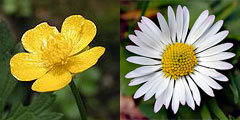 |
Buttercups and Daisies: Best left alone, but one or two in a mixed bunch are inevitable in summer and they will do no harm. They will cause no trouble if dried in hay. |
 |
Bluebells: Should be avoided. Deadly nightshade is well known but this is actually more dangerous to us than to rabbits. But this is a plant which is not made harmless by drying, so try not to get it in the hay. |
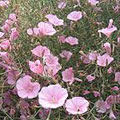 |
Bindweed: Apparently goats like this plant, but we are always careful to avoid it for the rabbits. The seeds are to be avoided at all costs. Black bindweed is worse than the lesser bindweed. |
 |
Celandine: Less dangerous in Spring, but more so later. Elder. A branch of this is good to keep flies away from the rabbits in Summer. It is a good insecticide, hence the leaves are too strong to eat. |
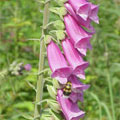 |
Foxglove: This is dangerous. The digitalin it contains is used to treat heart complaints in orthodox medicine. We once lost two cows through poisoning and the vet suspected the foxglove leaves which grew in the wall bottoms. Nothing was proved, but it made us very wary of this plant. |
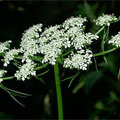 |
Fool’s Parsley: Rather like Cow or Hedge Parsley, This one causes convulsions; there are little ‘beaks’ under the flowers if you look for them. Hemlock is another poisonous plant, rather like the parsleys but bigger and coarser. Hemlock also gives off a nasty smell when bruised. In hay it is not so dangerous – we have harvested it by mistake and it has gone through with no ill effects. Socrates finished it all with hemlock, but I hope your rabbits will not do the same. |
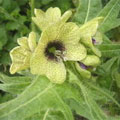 |
Henbane: One you are always warned about. I never seem to see it. Animals avoid it as it smells unpleasant. It’s a source of the alkaloid hyoscine used in medicine. |
 |
Poppies: That poppies produce opium is well known – a well-run rabbitry can do without them. |
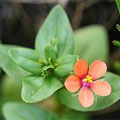 |
Scarlet Pimpernel: This is so small that it is not likely to be gathered, but it is poisonous. |
 |
Lettuce: The story-book rabbit food, rather surprisingly should be fed in strict moderation, since it has a soporific effect similar to opium – although I hasten to add that wild lettuce is much more effective than the garden variety. The substance in lettuce is called Lactucarium and has been used in sleeping medicines. |
I have mentioned a few garden plants to avoid and perhaps we can end with a few more. Potato and rhubarb tops are garden waste which would poison rabbits and strangely enough the leaves and stems of broad beans and runner beans are not good for rabbits. But pea haulm is quite harmless.
When finding wild plants to gather there are several hazards apart from being caught trespassing! However the law says in one judgment at least that it is no offence to take wild plants or to trespass to find them. Wild plants become your property when you gather them, unlike cultivated crops, which you cannot pick without stealing. But in spite of this I would feel happier with permission to gather rabbit food from private land, and I would recommend you to get permission before you start. Most farmers will allow you to gather rabbit food if you ask them.
Another hazard is pollution, which often affects common land these days. Many a roadside verge that fed our rabbits twenty years ago is now contaminated with petrol fumes from the volume of traffic. Choose wide verges and pick your plants near the hedge – and of course, the less frequented roads are the best. It is wrong to pull up plants by the roots – rabbits will not relish the soil for one thing, and also you are permanently removing the plant. Leave them so that they can grow again; you will know where to come next season.
Then there are’ the chemical sprays which can be deadly for livestock. These can come over hedges from the fields, so watch out for recent wheel marks on crops like half-grown corn. Grassland is not often sprayed wholesale, but patches of docks are sometimes treated. Sometimes the government sprays the roadsides to keep them in trim – this is a dreadful practice and is being discouraged. This is just as well for the future of our wild flowers.
- Why Why Keep Rabbits?
- Rabbits Past and Present
- Some Basic Information
- Making a Start
- Housing
- Feeding
- Growing Crops for Rabbits
- Breeding
- Health
- Harvesting the Wild Rabbits
- The Harvest
- Using Rabbit Meat
- Fur Production
- Showing
- Angoras
Further Research:
   |